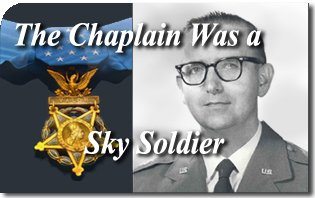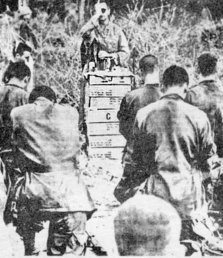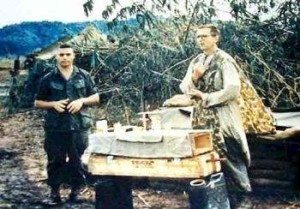
In the early morning hours of November 9, 1967, as American artillery and aircraft pounded an 875-meter-high hill near Dak To, Vietnam, Fr. Charles Watters offered Mass at its base. Many Protestants joined the Catholics for the well-attended service. Soon, the chaplain would accompany these paratroopers of the 173rd Airborne Brigade as they moved against a North Vietnam Army (NVA) unit occupying the hill. The commanding general of the 173rd thought the objective was held by a depleted enemy force that suffered heavy casualties in recent fighting. The occupiers, however, were a fresh NVA regiment of 2,000 soldiers.
At 9:43 am, 330 men in three companies moved out. Companies C and D advanced abreast, while Company A was behind to protect the rear. The weather was clear and warm. The advance was slow through the thick, tangled foliage of scrub brush, bamboo and tall trees. Unknown to the Americans, the enemy had been preparing the site for several months, constructing camouflaged bunkers interconnected with trenches and tunnels and storing extensive quantities of supplies. At 10:30 am, with the first troopers a few hundred meters from the crest of the hill, a well-concealed NVA force opened fire with recoilless rifles, automatic weapons, small arms, rockets and hand grenades.
Father Watters moved to the line of contact. When a wounded trooper was standing in shock in front of the assaulting forces, Father raced forward, picked the man up and carried him to safety. Soon after, he ran through intense enemy fire to aid a fallen soldier. The chaplain moved wherever he was needed.
When the fighting began, Company A, which was to the rear, began constructing a landing zone that could be used for resupply and evacuation of the wounded. The work was slow as the company was under occasional fire. Then, at 2:30 pm, enemy troops launched a massive assault from lower on the hill, driving the company upwards toward the other American units. The paratroopers had walked into a carefully prepared ambush, with enemy units above and below them.
With their advance halted, the Americans formed a defensive perimeter, bringing in their injured. As the men pulled back, the chaplain went into “no man’s land,” between the two forces, exposing himself to friendly as well as enemy fire to recover two wounded soldiers.

with the fighting men — in the combat zone.
The NVA were now striking from all sides in a well-coordinated attack. The paratroopers were firing intensely, but the NVA continued to come. When the American defensive zone was forced to contract, Father Watters saw several wounded men lying outside of it. Ignoring attempts to restrain him, he left the perimeter three times in the face of automatic weapons and mortar fire to carry and assist injured troopers to safety. Then he moved about, aiding the medics, distributing food and water, speaking words of encouragement, and giving last rites to the dying.
With the three companies now in a common defensive area, the several command posts and the wounded were placed in the middle. For several hours, the Americans fought off the enemy. The high expenditure of ammunition and lack of water made resupply essential, but heavy enemy fire made it difficult. Six helicopters were hit and driven away before one finally dropped needed supplies at 5:50 pm.
As the enemy assault intensified, U.S. air strikes and artillery were called in, but they had little effect because of the dense foliage. Then, just after dark, at 6:58 pm, a Marine Corps fighter-bomber released two 500-pound bombs destined for the edge of the American perimeter. One of them struck the upper part of a tree located near the center of the American position and exploded. Fragments of the bomb were showered over the area which contained the combined command group, the wounded, and the medics. It killed 42 men, including the chaplain, and wounded 45 others. This was one of the worst friendly-fire incidents of the Vietnam War.
Charles Joseph Watters was born in Jersey City, N.J., on January 17, 1927. After attending Seton Hall University, he went to Immaculate Conception Seminary, and was ordained a priest in 1953. While serving in several parishes in New Jersey, he earned a commercial pilot’s license, and then in 1962 joined the Air Force National Guard. Three years later, Father enlisted in the Army as a chaplain, successfully completed airborne training and was assigned to the 173rd Airborne Brigade, nicknamed the Sky Soldiers.
In June 1966, Father Watters, now a major, began a twelve-month tour of duty in Vietnam. He believed his place was with the fighting men, and so when a unit he was attached to rotated to the rear, he would join another unit in combat. He was constantly in motion, saying Mass, tending the wounded, joking with the men and giving spiritual guidance.

saying Mass shortly before his death.
In February 1967, he took part in Operation Junction City, which included the only combat jump of the Vietnam War. This helped endear him to the men, who knew he would risk his life with them. During this tour of duty, he was awarded an Air Medal and a Bronze Star with a V for valor.
When his tour ended, he extended for another six months. After the friendly-fire incident in which Father Watters was killed, the Americans took Hill 875, and significantly crippled the fighting effectiveness of the North Vietnam units they fought. Fr. Charles Joseph Watters was posthumously awarded the Medal of Honor, and has had schools, a bridge, a Knights of Columbus council, and the Army Chaplain’s School named after him.
About the Author: Lawrence P. Grayson is a Visiting Scholar in the School of Philosophy at The Catholic University of America. He also serves as State Director for Pro-Life Activities, Knights of Columbus, Maryland.
Related Articles: Catholic Military Chaplains: America’s Forgotten Heroes
Fr. Emil Kapaun: The Good Thief
